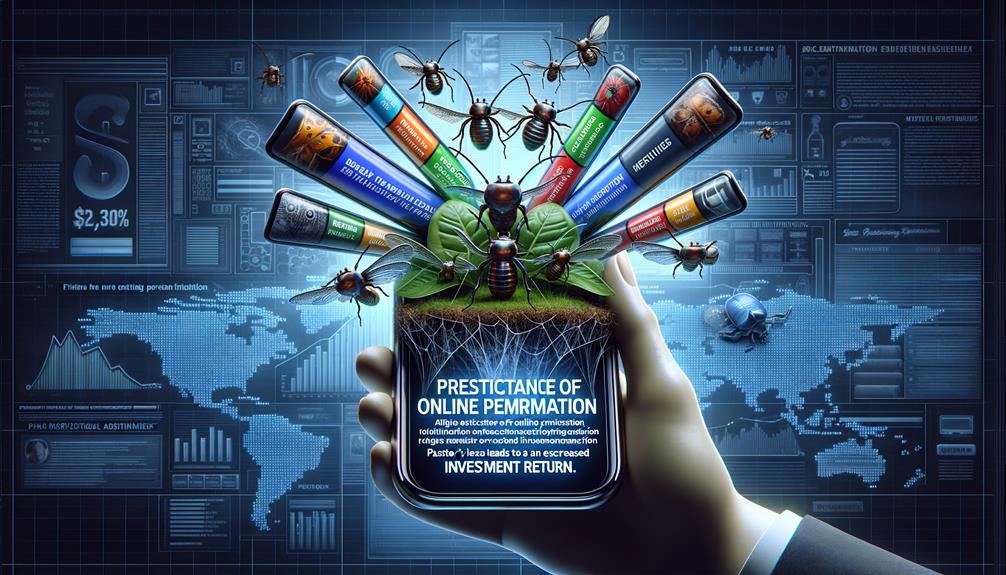Looking to grow your pest control business? Social media advertising offers a powerful tool to boost your return on investment (ROI). By targeting the right audience, creating engaging content, and tracking campaign performance, you can maximize conversions and revenue.
But how exactly can you achieve this? In this guide, we will explore the steps and strategies to effectively use social media advertising for your pest control business.
So, if you’re ready to take your marketing efforts to the next level and see real results, keep reading to discover the secrets of successful social media advertising for pest control ROI.
Table of Contents
ToggleKey Takeaways
- Social media advertising can greatly benefit pest control companies by increasing brand awareness, reaching a wider audience, building credibility, driving customer engagement, and establishing a loyal customer base.
- Targeting the right audience is crucial for successful social media advertising. This involves dividing the target market into specific groups based on demographics, interests, and behaviors, and tailoring advertising messages to resonate with each group.
- Creating engaging content is essential to capture the attention of social media users. Pest control companies can use visual storytelling, eye-catching images, videos, and infographics, as well as before and after pictures and short videos demonstrating their expertise. Providing value to the audience through tips, advice, and educational content is also important.
- Tracking and analyzing campaign performance is necessary to measure the success of social media advertising efforts. Setting clear goals and metrics, using tracking tools provided by social media platforms, monitoring impressions, reach, engagement, and conversions, and analyzing data to identify patterns and trends are all important steps in optimizing campaigns for better results.
Benefits of Social Media Advertising

Social media advertising offers numerous benefits that can significantly improve the return on investment (ROI) for pest control businesses.
One of the key benefits is the ability to increase brand awareness. By leveraging social media platforms, such as Facebook, Instagram, and Twitter, pest control businesses can reach a wider audience and promote their services effectively. With billions of active users on these platforms, businesses have the opportunity to showcase their expertise and build credibility in the market.
Moreover, social media advertising also drives customer engagement. Through targeted ads, businesses can engage with potential customers and encourage them to interact with their brand. This can be achieved through various means, such as contests, surveys, or simply by providing valuable content that sparks conversations. By actively engaging with customers, pest control businesses can establish a loyal customer base and increase the likelihood of repeat business.
Data-driven insights further enhance the benefits of social media advertising for pest control businesses. Through analytics tools provided by social media platforms, businesses can track the performance of their ads and make data-backed decisions to optimize their campaigns. This allows businesses to allocate their advertising budget more effectively, ensuring that their message reaches the right audience at the right time.
Targeting the Right Audience
To maximize the effectiveness of social media advertising for pest control businesses, it’s crucial to target the right audience with precision and accuracy. Audience segmentation and ad targeting techniques play a significant role in achieving this goal.
Audience segmentation involves dividing your target market into specific groups based on characteristics such as demographics, interests, and behaviors. By understanding your audience’s needs and preferences, you can tailor your advertising messages to resonate with them on a deeper level. For example, if you offer pest control services for both residential and commercial properties, you can create different ad campaigns to target homeowners and business owners separately.
Ad targeting techniques enable you to reach the right audience at the right time. Social media platforms provide a range of targeting options, including location, age, gender, interests, and online behaviors. By utilizing these tools effectively, you can ensure that your ads are shown to individuals who are most likely to be interested in your services. For instance, you can target users within a specific geographic area where pest problems are prevalent.
Creating Engaging Content

Now that you have targeted the right audience, it’s time to create engaging content that captures their attention and drives results. A strong content strategy is vital for social media advertising success in the pest control industry. With so many competing businesses vying for attention, you need to stand out from the crowd.
One effective approach is visual storytelling. People are more likely to engage with content that tells a compelling story. Use eye-catching images, videos, and infographics to convey your message in a visually appealing way. Show before and after pictures of pest infestations your company has successfully resolved. Create short videos that demonstrate your team’s expertise and showcase the positive impact you’ve had on your clients’ lives.
Another key aspect of engaging content is providing value to your audience. Offer tips and advice on how to prevent common pest problems. Share educational content that helps people understand the importance of professional pest control services. By positioning yourself as a trusted resource, you build credibility and establish a strong connection with your target audience.
Tracking and Analyzing Campaign Performance
It is essential to track and analyze the performance of your social media advertising campaigns to ensure that you’re achieving your desired results and maximizing your return on investment. By measuring the success of your campaigns, you can identify areas of improvement and make necessary adjustments for campaign optimization.
Here are three key steps to help you track and analyze the performance of your social media advertising campaigns:
- Set clear goals and metrics: Before launching your campaign, establish specific and measurable goals. Determine the key metrics you’ll use to evaluate the success of your campaign, such as click-through rates, conversions, or engagement rates. These metrics will provide valuable insights into the effectiveness of your campaign.
- Use tracking tools: Utilize tracking tools provided by social media platforms, such as Facebook Ads Manager or Google Analytics, to monitor the performance of your campaigns. These tools provide data on impressions, reach, engagement, and conversions, allowing you to evaluate the success of your ads.
- Analyze and optimize: Regularly review the data collected from your campaigns and analyze the results. Identify patterns and trends to understand what’s working and what needs improvement. Adjust your targeting, messaging, or budget as necessary to optimize your campaigns for better results.
Maximizing Conversions and Revenue

By optimizing your social media advertising campaigns for maximum conversions and revenue, you can further enhance the success and profitability of your pest control business. To achieve this, it’s crucial to focus on improving click through rates and optimizing ad placements.
Improving click through rates is key to increasing conversions and revenue. Start by crafting compelling and attention-grabbing ad copy that clearly communicates the value and benefits of your pest control services. Use strong call-to-action phrases that encourage users to click on your ads. Additionally, consider using eye-catching visuals and engaging videos to capture the audience’s attention and entice them to learn more about your business.
Optimizing ad placements is another effective strategy to maximize conversions and revenue. Identify the social media platforms where your target audience is most active and allocate your advertising budget accordingly. Conduct thorough research to understand the demographics and interests of your potential customers, and then strategically place your ads on platforms that align with their preferences. This will ensure that your ads are seen by the right people at the right time, increasing the likelihood of conversions and generating higher revenue.





